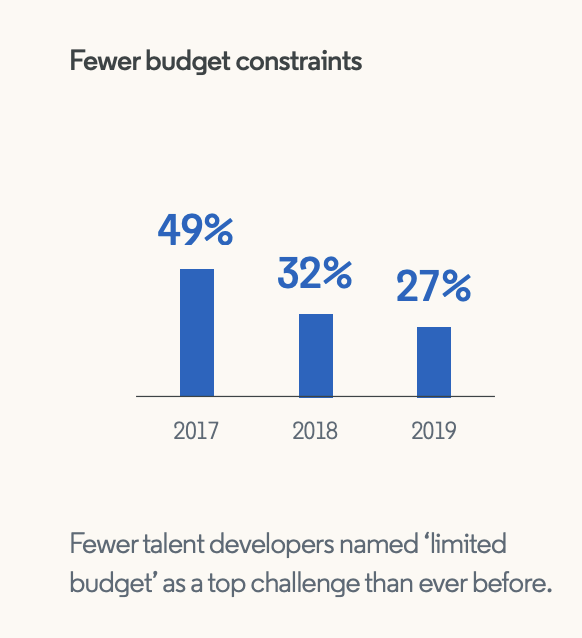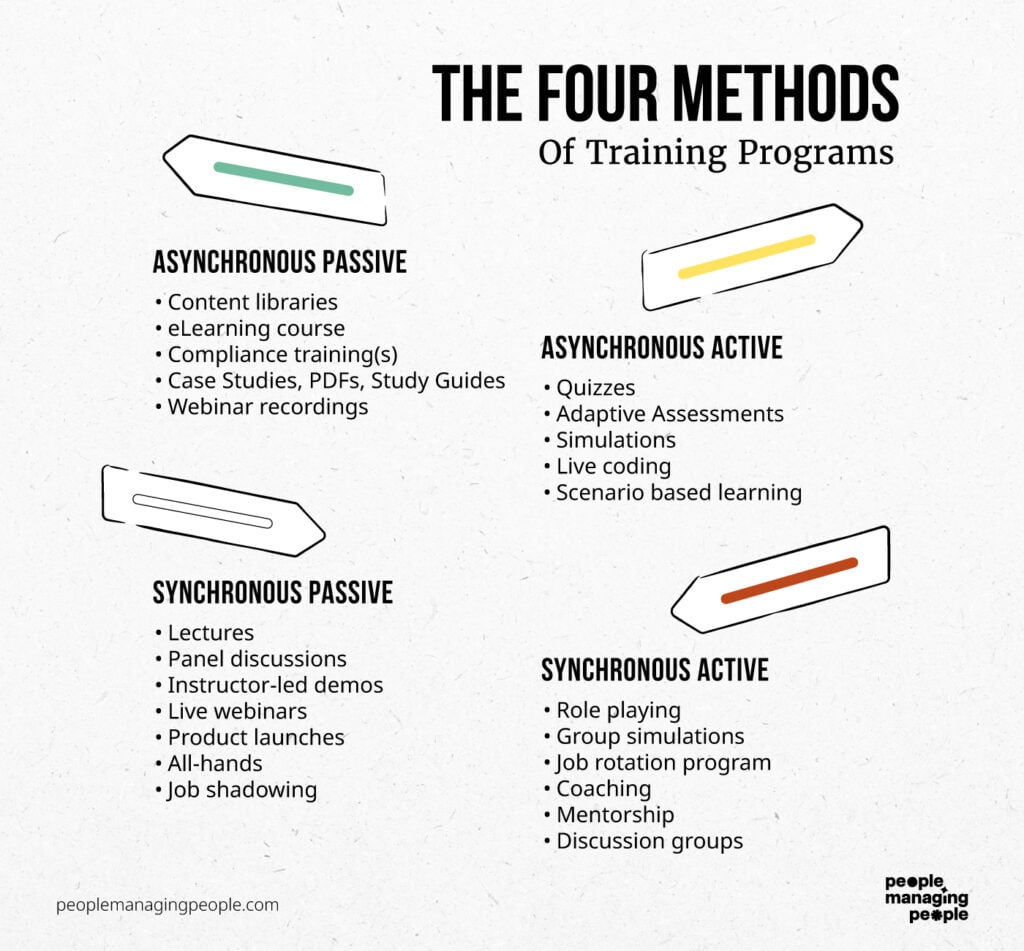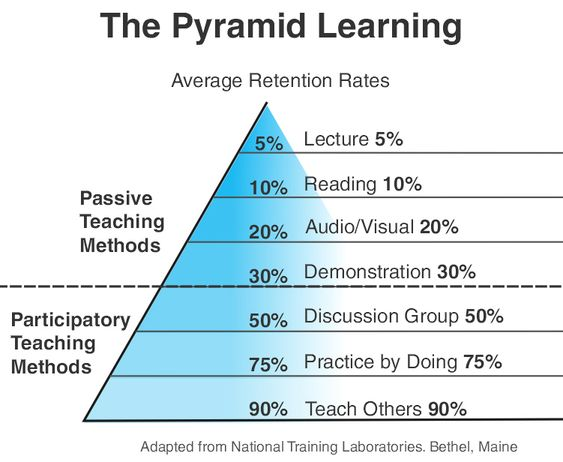An important thing happened in the learning and development space around 2016. New research started pouring in that showed that employees having access to career development and growth opportunities (i.e. corporate learning) would increase their engagement and retention.
This was a BIG deal because, previously, these two things—employee engagement and retention—had been ranked as the two largest problems in HR and people teams.
In the years that followed, this led to a huge spending increase in employee training programs, as you can see here from LinkedIn’s 2019 Workplace Learning Report on “budget” being a declining concern for L&D teams.

All of a sudden, business leaders were asking for more learning—and fast. And they were, at that time, fairly indiscriminate about the type of learning they wanted because the research hadn’t specified or been granular about types of learning.
It had just said that any learning—whether it be instructor-led training, eLearning, on-the-job training, etc.—would be beneficial to bottom-line metrics.
And so the industry took off. Tools like LinkedIn Learning were born out of a massive acquisition. Sites like MasterClass and Khan Academy took off. L&D teams doubled and tripled in size. Budgets for employee development followed suit.
And because we, in the industry, wanted to move fast, much of the training techniques that were prioritized were the cheapest, widest, and easiest accessible like big content libraries and MOOCs. COVID then accelerated many of these trends in online learning (which already fit that widest category), and here we are today.
Today, many corporate L&D programs have become a portfolio of custom content created in-house, third-party content providers, and tools to access open trainings on the internet. Within each of these could be dozens of tools all potentially funneling in and out of an organization’s LMS.
It’s become quite the hodgepodge for employees to sift through and it means there are tons of different paths, avenues, or ways in which employees can learn.
Which is why I laughed when I was asked to write an article about the most effective employee training methods.
For one, there are hundreds of methods available. This article itself is a method of training people.
And for another, there is “best” in a vacuum, it should depend on what your goals are. The best employee training programs are the ones aligned to specific outcomes.
So I wanted to approach this article from the angle of that big boom a few years ago, what's gained traction and why, and explore it from a lens that would let me think about the future of L&D and training programs.
I think I’ve gotten there by putting the methods for training employees into 4 categories and dividing offerings between asynchronous and synchronous learning and then active and passive offerings within those.
I’ll spend the rest of this article going into these, but first let’s briefly discuss why it’s important to adapt your learning strategy around these different categories.
We want diversity in workplace training because we know that traditionally-described learning styles don’t exist (though don’t let this distract from the idea that we would all benefit from completely personalized learning).
Adult learners, particularly those looking at developing a professional skill, come in with a multitude of backgrounds and notions about how to approach their own learning. So in trying to cater to a variety of people, we want to offer a variety of learning approaches.
There is no one-size-fits-all approach and a good L&D team will have several methods planned and ready to help their audiences meet their training needs. This ensures that there will be enough, quality content for anyone who is ready to learn.
The Four Methods Of Training Programs

Asynchronous Passive
Our first category has seen the biggest rise in popularity over the last decade. Asynchronous learning done passively—by which I mean taking in information by reading, watching, or listening—has itself turned into a multi-billion dollar industry.
Most commonly, this bucket arrives as online learning (or eLearning), and its rise in popularity is because it’s cheap and easy to make.
It can, as simply as buying one of a dozen platforms out there, be made available and applicable to wide swaths of your employee base.
Think of tools like LinkedIn Learning, Masterclass, or Khan Academy. These are tools with libraries of videos in the thousands, delivering value through soft skill engagement and reflection.
They are mostly completed individually without little or no interaction (the “active” part I’ll describe below) with the learner. The majority of compliance learning (again, another billion-dollar industry) is like this as well, and Human Resources teams seem content to keep it that way.
The goal of asynchronous passive training is often the transfer of information or ideas.
It does not excel in behavior change because of the passivity aspect, but it can be taken so flexibly (in small doses, for instance as micro-learning) that there is tremendous value at scale for organizations to offer this.
Where providers of this type of learning have hooked onto is this idea of giving this type of training material in the flow of work, because that helps to solve the gap here: needing to put this kind of information transfer into an applicable state.
It turns it from passive to active, but the learning itself does not need to provide activities like hands-on learning, active or adaptive testing, or live practice environments.
So why choose this method?
Because
- You likely need to get an eLearning module out to everyone, as is the case in corporate compliance training, or
- You have a change you want to share with your entire organization: a new company value or case studies you want your Sales team to be aware of. You can put a SCORM file in your learning management system, send an email, and wait for people to engage with the training.
What you shouldn’t bank any hopes on from this method is direct skill transfer, social learning, or behavior change because those all need practice, places, or care to build.
However, there is still high value in asynchronous passive learning from the angle of providing information and context. It’s as necessary as the buckets below.
Asynchronous Active
Next we have asynchronous active training. Asynchronous again meaning that this can be taken at your own pace, or whenever someone likes or flexibly within a window.
It can be done as a cohort or group but will rely on communications like messaging or a forum because learners will be at different points in their journey.
This differs from the previous bucket in that it is an active learning experience—generally meaning there is an amount of interaction that the learner does with someone or something like a piece of technology.
Some examples here would be quizzes, personal simulations, and live coding or practice environments—generally things that can be done alone and do not involve classroom training.
The best of them will have real-time feedback loops for learners like finding coding errors, adaptive assessments, or gamified environments that are unique for each user.
Generally speaking, these kinds of active learning opportunities are richer experiences than passive examples in online learning described above. Training methods that include interaction have been shown to maintain skills and retain information longer.
But any kind of active or participatory learning is slower and more expensive to build, so approach this carefully.
For example, if your goal is telling new team members all about their new resources during onboarding, you may not need an active session because you’re just looking to inform them.
But, if you want to take a group of people and help them build new skills or enhance old ones, active learning is a near necessity.
What you’ll need to do as a learning professional is balance out the cost and reward of this type of training method.
If building out (and don’t forget maintaining) a personal simulation is costly (and a good one would be), then you need to measure how people feel, act, and assess afterward.
What behavior did you actually seek to change and how well did your learning initiative accomplish that?
The good news is this: active learning is going to get cheaper and more abundant.
AI and other technologies that are labeled “generative” mean that we’ll be able to make content and experiences quicker and better than before—and for many that will mean a huge boon in asynchronous offerings available to anyone at any time.
AI can personalize an experience (like unique quizzes or checkpoints) much, much quicker than a learning designer or engineer could, and so we may find ourselves seeing cost and time needs for this type of learning drastically reduced. That would be an important change here and active learning of all kinds should see a move to massive participation in the future.
Synchronous Passive
Now we move on to synchronous training which is done at a certain time or place and on schedule.
This is better for group training where you’d like everyone to get the same training at the same time. The “passive” part here again refers to a learner who is just absorbing information and not acting or practicing that during the learning program.
Common examples here are initiatives like lectures, panel discussions, instructor-led training or demos, or live webinars.
But they can be more unique offerings like product launches, all-hands meetings, or even something like shadowing where a session is scheduled for one person to watch or oversee another.
Since employees often do onboarding in their first few weeks, many companies choose to make this category part of that experience.
Make no mistake, synchronous training offerings can be effective and an effective vehicle for learning teams to ensure that information makes it to certain people at a certain time. For something like preparing for a product launch, this is invaluable.
But, as you can see below, lectures have the lowest retention rates of the several types of learning listed.
That’s mostly due to the passivity here (and in the asynchronous passive learning above). You can see some other learning initiatives in this bucket listed below that have better retention rates like Demonstration.

My point is that this category is not to be avoided. Lectures, even more than eLearning, require some of the least preparation and resourcing out there.
Find an expert and put them in front of a crowd and BOOM you’re training! And, if you look closely, the person who is doing that lecture is actually undergoing the learning experience with the highest retention (Teach Others).
For organizations, this is likely to be the least effective of the buckets because, if you’re going to bring people together, why not add in some participatory learning, right? Why make your employees sit through a speech or long video training without involving them?
Still, there is no reason synchronous passive sessions can’t be an effective way for employees to learn. A good example here is an all-hands/town hall when a leader gets in front of their employees and inspires them together to achieve a difficult goal.
Synchronous Active
Our final category is the most difficult to consistently pull off but the rewards can be great.
It necessitates bringing a learner, or multiple learners, into a synchronized training experience (same place or time) and offering something interactive for them.
Common examples here would be role-playing and simulation learning, but could also be something as long-term as a job rotation program.
In each of these examples, people come to a learning experience and take part in something.
Generally, this will be a form of feedback or interaction with a group—a discussion, debate, or team-building activity.
The benefit here is not just in that instant feedback mechanism but in the potential to reflect—on your own or with others—on what’s happened.
It’s safe to say that this is generally going to be the most rewarding type of training to build skills within a community.
If you’re at an organization and building out your library of employee training methods, you generally want to aspire to create this learning experience when you can.
Learners work together, grow together, and share a consistent experience they can take back to their work with them.
Synchronous training enables cohort and group learning, which has the awesome power of reflection, sharing, mentoring, and coaching (to name a few) opportunities baked into it.
And because it can upskill an entire group at once, aligning groups of people (like managers or leaders) to single competencies, it’s popular for businesses looking to sync their leaders or managers to one specific skill set.
Personal opportunities like mentorship often get bucketed here, though a good mentor probably finds ways to influence asynchronously.
Typically, a mentor may set up times to talk (like a coach would as well) and thus you’ve found yourself doing synchronous work with another person.
Of the types of employee training, this one can also feel the most familiar. Pre-internet, most training was done at a certain time and place and many companies have held onto that—not because it’s familiar but because it works!
After all, the crux of a standard K-12 academic approach is done during a set in-person, weekday schedule.
But there are risks here. You are taking a lot of people’s time. Gathering a group of learners together requires not just logistics (especially if it’s in-person) on a training team’s end but also the commitment of time from participants.
If you want to go deep into a learning experience like simulations, you’re asking people to abandon their regular jobs for some period of time to learn new skills.
It’s also harder to build this type of training. You’re generally trying to apply an active or participatory learning program to a group that is likely coming in with a diversity of levels and experience.
You may not, and likely will not, get the same effect from the experience in all learners. Hands-on training in this methodology is also the costliest approach so these risks are not to be ignored.
My advice is not to default to this method but to be careful about when it’s used. When done right it can have outsized, positive effects. But a missed opportunity here, unlike other formats, can really damage a learning brand and learners' trust in what you’re building.
Considerations When Choosing A Training Method
How do you decide which of these four categories to move forward with?
Well, you’ll need to consider and be intentional about what you’re trying to achieve.
If it’s a simple knowledge transfer and you don’t want it to be time-consuming, you may choose to build an eLearning that employees can take asynchronously and passively.
Of course, things like location, budget, resources, and timeline will impact this decision. I get that. But think of these as variables and trade-offs.
If you can predict that synchronous training is the best option, but budget and timeline won’t allow for it, then we’re automatically in a compromised state and we should reflect and share the risks of moving to another category.
The simple rule is that the best learning opportunity is the one that is going to get learners to adopt the behavior you’re seeking or transfer the information you want.
Whether that’s done with interactive training, a specialized facilitator, or simply a long-form article with some nice graphics, it’s ultimately about the outcome.
The Future Of Employee Training Programs
As mentioned, the future is really bright for all four of these buckets.
Learning, in every single way, is going to get better with new technology and AI-enabled personalization.
Just the same, each of these buckets has room to improve how it delivers learning value to audiences, whether their new hires to an organization or C-level leaders.
The training sessions of the future should and will look a lot different than today.
One overriding trend I’d be comfortable predicting, though, is that the asynchronous learning buckets are going to get a larger share of future learning innovation.
Simply put, our busy and global world is going to look for equitable solutions that people can train and learn on their own time.
Technology will be the enabler to deliver the richness of shared experiences to us on our own; though we should be very careful to abandon synchronous options altogether.


